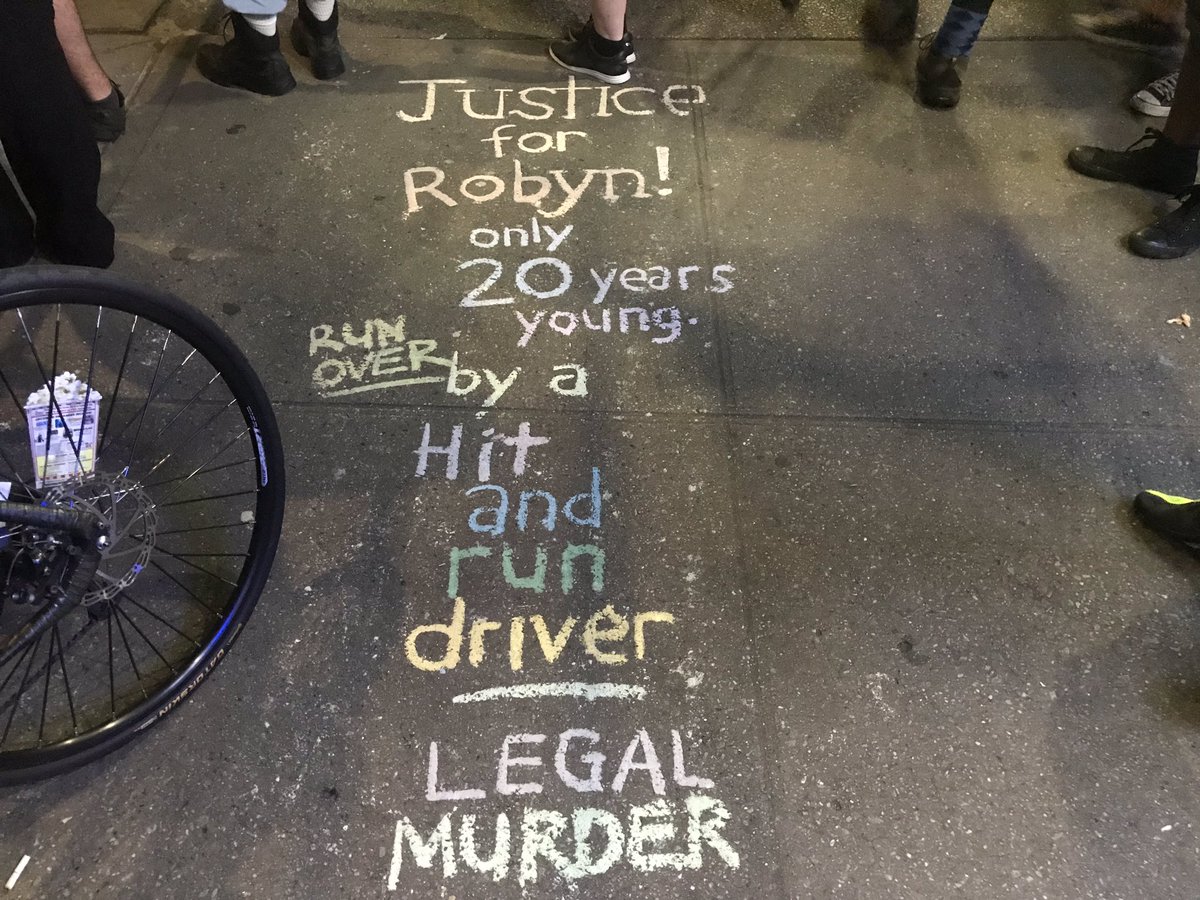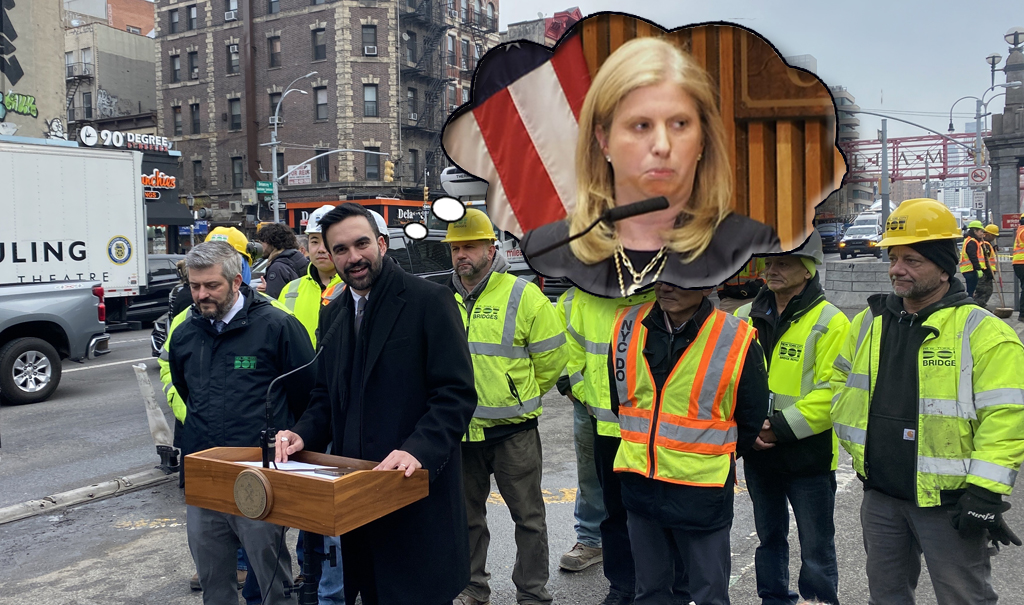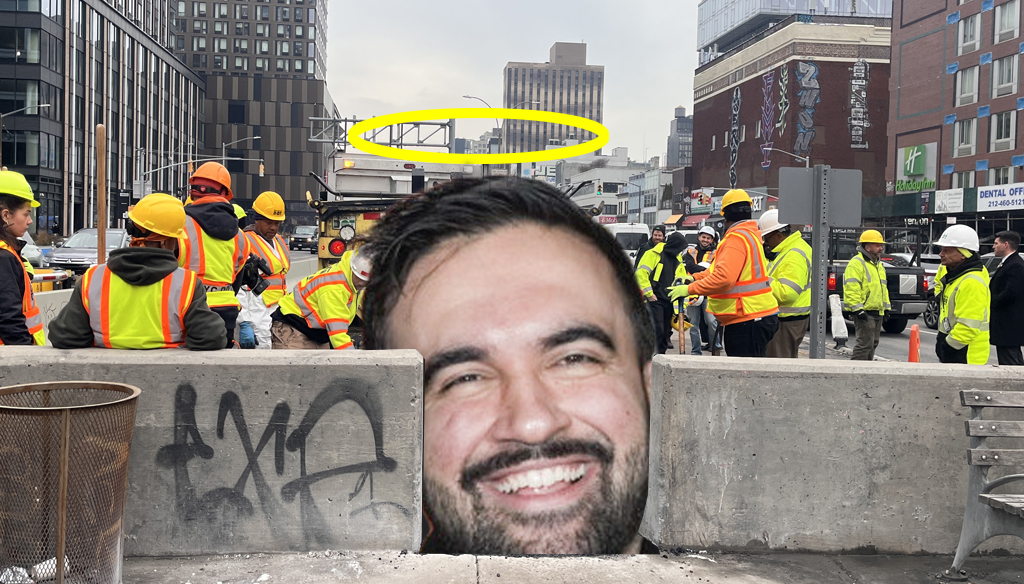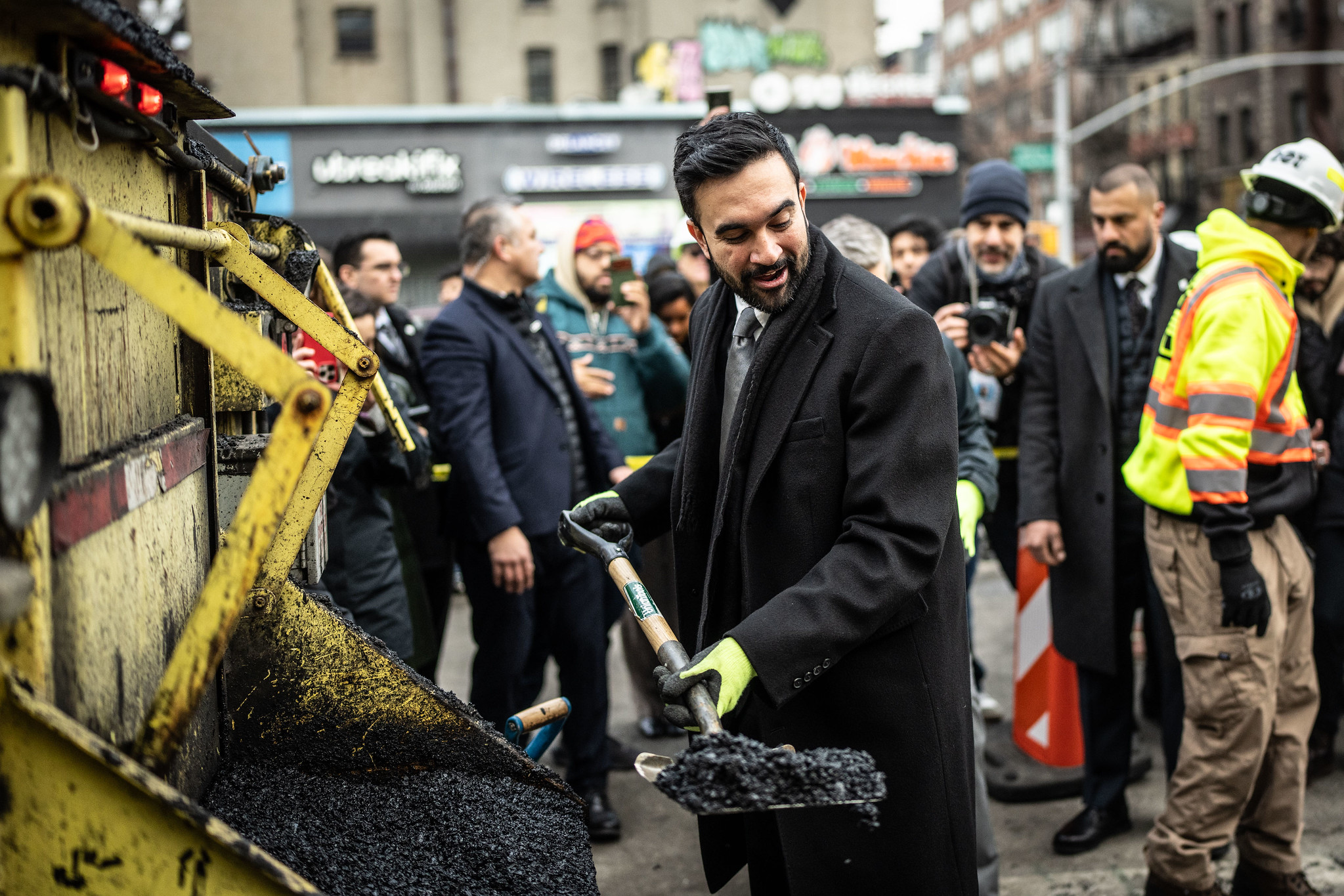Nearly six months after a hit-and-run truck driver fatally ran over 25-year-old Aurilla Lawrence, Brooklyn District Attorney Eric Gonzalez announced that he would not prosecute the fleeing driver — leaving Lawrence’s grieving family and friends without justice.
“It’s absolutely outrageous,” said Lawrence’s sister, Kathryn, after hearing the news. “I’m trying to wrap my head around it.”
Everyone is. But it's also not entirely shocking — prosecutors frequently decline to charge killer drivers with a hit-and-run due to a welter of factors, including a strict state law that leaves prosecutors hands tied; NYPD investigations that are flawed, rushed, and understaffed; juries of their peers stacked with empathetic drivers; and a general sense that vehicular crimes are not treated with the same level of seriousness as other crimes.
“We still have prosecutors who refrain from bringing charges that they would have brought without hesitation had the dangerous instrument been anything other than a vehicle,” Marco Conner, co-deputy director of Transportation Alternatives, told Streetsblog.
Take the case of 4-year-old Luz Gonzalez. On June 24, 2018, hit-and-run driver Jeanette Maria ran over and killed the child on a Brooklyn sidewalk. Brooklyn DA Gonzalez still has not charged Maria — who claimed she didn't know she had hit anyone — even though the case is "clearly chargeable," one attorney said. Gonzalez's family is now seeking the last resort of justice: a civil lawsuit against Maria, the city, and the owner of the laundromat where Gonzalez was killed.

Gonzalez and Lawrence are just two of the hundreds of victims who aren't receiving justice: out of the 5,699 hit-and-run crashes involving injury last year, only 492 people were arrested — a rate of less than 9 percent.
But even then, an arrest doesn’t always mean a conviction, or what advocates argue is a fair punishment for taking someone’s life.
“Our city’s unofficial policy for too long has been that no matter how reckless, dangerous and harmful a person’s driving, there will never be consequences and oftentimes the driver will remain on the road,” Brooklyn State Senator Andrew Gounardes said.
When police arrested a hit-and-run driver for fatally running over a cyclist in Manhattan back in February, they charged him only with the far less serious crimes of failing to yield and failing to exercise due care — charges that come with a maximum sentence of 30 days in prison, but which are rarely handed down in such cases. Police did not charge the driver for actually fleeing the scene, which comes with a maximum of seven years in prison, likely a result of the driver’s lawyer also claiming that “he was unaware that he had hit anybody” — magic words that often help killer drivers avoid being held accountable for their reckless actions while behind the wheel.
But rather than claiming ignorance as a way to absolve drivers of a crime, it should actually be proof of guilt, like it is according to civil law, says personal injury attorney Daniel Flanzig.
“ ‘I didn't feel it' is not an excuse, it’s an admission. You’re obligated to see what's there to be seen,” Flanzig said.
Streetsblog has reported on many such cases of the police accepting those words as gospel, dating back to at least 2011, when cops declined to charge the hit-and-run driver who killed 30-year-old cyclist Mathieu Lefevre. Very little has changed.
The truck driver who killed Robyn Hightman on June 24 — exactly one year after Gonzalez was killed — told Streetsblog just that: he “didn’t know” he hit the cyclist. Cops sent the 54-year-old driver, Antonio Garcia, on his way with a pat on the back and without so much as a ticket for failing to yield to Hightman or failing to exercise due care.
The truck driver who fled after killing Linda Douglas on Flatbush and Nostrand avenues earlier this year? He also claimed he “didn’t know.”
And after months of investigation, Brooklyn prosecutors declined to charge the hit-and-run private sanitation truck driver who killed 27-year-old Neftaly Ramirez in Greenpoint in June 2017. But even before that, just weeks after Ramirez was killed, law enforcement officials had already made up their minds that the driver did nothing wrong. Officers were quick to absolve the Action Carting driver — who was behind the wheel of his massive truck without the proper license — because he also used the same magic words.
“If someone hits someone and it’s a big gigantic garbage truck and they don’t know they hit him, you can’t charge someone with a crime,” Lieutenant John Grimpel said at the time.
Breaking down the law
Law enforcement officials claim it is hard to arrest hit-and-run drivers — as Brooklyn DA Gonzalez claimed after declining to charge the truck driver in the Lawrence case. But is it really so tough?
Prosecutors rely on the New York State statute, known as VTL 600, to charge drivers for leaving the scene of an “accident.” The law itself suggests that a driver can only be charged with fleeing the scene if he or she leaves “knowing, or having cause to know, that" he or she injured someone else.
To be complete, here's the full legal definition of hit-and-run:
Any person operating a motor vehicle who, knowing or having cause to know that personal injury has been caused to another person, due to an incident involving the motor vehicle operated by such person shall, before leaving the place where the said personal injury occurred, stop, exhibit his or her license and insurance identification card for such vehicle, when such card is required pursuant to articles six and eight of this chapter, and give his or her name, residence, including street and street number, insurance carrier and insurance identification information including but not limited to the number and effective dates of said individual's insurance policy and license number, to the injured party, if practical, and also to a police officer, or in the event that no police officer is in the vicinity of the place of said injury, then, he or she shall report said incident as soon as physically able to the nearest police station or judicial officer.
“The evidence has to point that you knew, or should have known, you struck a person, and that’s what the investigation is designed to determine,” said Jon Shane, a professor at the John Jay College of Criminal Justice. “It’s physical evidence, witness statements, it’s video.”
The Ramirez family lawyer — who also filed a civil suit against the truck driver, his passenger, and the private sanitation company, Action Carting — says that prosecutors balk at bringing cases against drivers who claim they didn't know they hit someone because they're afraid to bring a case that they may lose before a jury packed with empathetic drivers.
“The basic defense is, ‘I never knew I hit them,’ and then it becomes a 'he-said, she-said' thing. That’s not gonna be enough for prosecutors,” said Michael Kremins, of the personal injury firm Raskin and Kremins. "A lot of times in hit-and-runs, they don’t even have a complainant because the person is seriously injured or dead. In a criminal case, you need to convict beyond a reasonable doubt. It’s a very high burden — a lot of prosecutors don’t want to unless they are sure they will be successful and get a conviction.”
Kremins still believes prosecutors should have charged the Action Carting driver in the Ramirez case because if the driver had been paying attention, he would have seen Ramirez before fatally running over him.
“They felt there wasn't enough there," Kremins said. "We disagree. We think there was enough for criminal negligence and leaving the scene. If the driver was paying attention to the roadway, he had to have seen the biker before he passed him. ... If the driver was paying attention to the road like he should, then Neftaly would be alive still.”
Prosecutors seem to only act if it's 100 percent clear the driver knew what he or she had just done, yet heartlessly fled the scene anyway. But it’s not that cut and dry, according to attorney Steve Vaccaro. The evidence isn't always going to be as damning as the driver texting someone, “Shit, I just hit and killed someone."
In the Gonzalez case, Maria's car is clearly seen on video bumping up and down as the vehicle runs over Gonzalez. The video — and the fact that Maria was driving on a sidewalk — should have been enough to charge her with a hit-and-run because any reasonable person should have had “cause to know” that she just ran over something or someone, said Vaccaro.
“If your vehicle is visibly rising and falling as the wheels pass over the body of a victim, you have a duty to stop and see what it is you ran over,” he said. Anything else is recklessness, at the very least.
Neither Vaccaro, Shane, or Kremins know of any studies that prove whether drivers in vehicles ranging in size should be able to feel that they just ran over someone. But the excuse is utter nonsense — truckers say they can feel running over something as small as a rodent.
“That’s a lie,” Rafael Saavedra, who has been driving trucks since 1988, told Streetsblog during a vigil earlier in July for slain cyclist Ernest Askew. "I’m here to tell you I’ve run over squirrels and I still remember to this day I’ve only run over one cat — I felt every single one of them and that’s a small animal so there is no way, no possible way in this world, where a truck driver can convince me that they don't feel a human body with a metal bike frame."
Vaccaro accused law enforcement officials of not wanting to put in the hard work of prosecuting the law to its fullest extent.
“The law has been written by cowardly police and prosecutors afraid of what difficulties they may encounter trying to prove beyond a reasonable doubt," he said. "The fact is so many of these investigators and prosecutors are lazy and looking for an easy way, want to come up with a pat answer that there wasn't a crime because then they have to do less work.”
But taking the easy way out, and letting drivers like Maria and Garcia off the hook, does little to enforce the rules of the road and prevent the next person from being killed, said Vaccaro.
"There’s two pathways for proving the guilt of a hit-and-run driver: one is the text message, ‘I just ran over someone,’ and the second is prove they have knowledge of facts that put them on notice they may have committed a crime. That’s the distinction here, law enforcement, prosecutors, and shockingly even judges don't get," he said. “If we’re going to have meaningful traffic law enforcement, we got to enforce the other part of the law — where is the 'has cause to know?'"
But one Brooklyn Assembly Member, who was an Assistant District Attorney in the 1970s, said that making a criminal case against a hit-and-run driver is much harder than in a civil case because the accused’s entire livelihood is at risk. But prosecutors do not just take a driver’s word for it that he or she “didn’t know” — they must have substantial evidence to prove, beyond any reasonable doubt, that the driver knowingly fled the scene.
“(Civil cases) it’s a lesser standard of proof, but in criminal cases, it’s made harder to do because life or liberty is at stake. The standard of proof is always beyond a reasonable doubt,” said Assembly Member Joe Lentol. “Sometimes the evidence is just not there. You can’t just rely on saying that he’s lying — even if it sounds fishy, have to have the goods to prove it. You need concrete evidence.”
But Lentol is no friend to reckless drivers either — he introduced legislation last year to increase penalties for hit-and-run drivers who kill — making it on par with drunk drivers who kill. Currently, he said, drivers are incentivized to flee the scene because the penalties for a fatal hit and run are not as severe as for a fatal DWI.
“We have to equalize the penalty because usually a person thinks the better course of action is to run away from accidents, especially if they’re intoxicated,” said Lentol.
The bill, which never made it out of committee, also includes a public education campaign for drivers to understand the importance of staying at the scene of a collision because someone’s life may be at stake, he said.
Lentol, nor any of the other experts Streetsblog spoke with, know of any pending legislation to change the wording of the VTL 600 in order to make it easier to charge a hit-and-run driver.
Better investigations
The NYPD has repeatedly rejected additional money to beef up the understaffed 26-member Collision Investigation Squad that investigates road collisions.
Every year in the five boroughs, there are roughly 225,000 crashes, with about 45,000 of them causing injuries. Roughly 2,000 to 3,000 of those crashes cause death or serious injuries — yet the Collision Investigation Squad investigates just 5 percent of those crashes every year, roughly about 150 collisions, according to a City Council report. That's not only a paltry fraction of the crashes where someone dies or is likely to die, but not even all of the fatal crashes every year.
So is it any wonder that of the 5,699 hit-and-run crashes involving injury last year, only 492 people were arrested — a rate of less than 9 percent?
It is unclear why the citywide arrest rate and the investigation numbers are so low. Clearly, many hit-and-run drivers are never caught. But, more disturbingly, some who are caught are still not charged with a hit-and-run. The NYPD declined to provide a breakdown.
What is clear, though, is that when cops take investigations seriously, they can yield good results. From June 2018 through June 2019, cops arrested 30 hit-and-run drivers who had killed or critically injured 51 people.
But the Collision Investigation Squad doesn’t currently have the manpower to respond to every case and especially not all of the hundreds of less-serious, but still important, crashes that happen daily.
Council members recognize this and want to increase the squad's budget by $2 million so it can add 15 more detectives to its team to "allow for more effective investigations and help find those responsible for fatal and near-fatal accidents" — but NYPD Commissioner James O’Neill said in May that he doesn't want it — yet.
But with total road fatalities up by at least 25 more people through this time last year, it's a mistake for the NYPD not to take the extra money so it can improve its team, said Transportation Alternative's Marco Conner.
“It’s long been recognized a need for expanding CIS,” Conner said. “When someone is seriously injured or killed, the victim cannot often speak for themselves. You just end up with the driver saying the victim jumped out between cars. A CIS investigation can delve further into it — they can come in and really shed some light on it. We all benefit when we have more data. It’s harder to establish facts, harder to bring charges if appropriate, harder to really hold the driver accountable.”
A former prosecutor with the Manhattan District Attorney's office reiterated that the city’s Collision Investigation Squad lacks the resources needed to carry out full-fledged investigations in every case — that coupled with prosecutors' doubts of securing a conviction and not taking traffic crimes as seriously as other homicides contributes to an unacceptable investigation and arrest rate in hit-and-run fatalities.
“Very few cases actually get even investigated, we know that," said Bennett Gershman, a professor now at Pace University's School of Law. "Absolutely they should be taken more seriously and they should be prosecuted when they can be.”
Gershman said police and prosecutors seem to be giving motorists a free pass to drive recklessly behind the wheel without holding them accountable, referencing little Luz Gonzalez, and the now 21 cyclists who have been killed this year on top of the dozens more pedestrians.
“The city still appears to be giving motorists almost a license to kill. It seems that the enforcement is so lax as to be almost scandalous. The city has to decide: do they want to become more aggressive in dealing with recklessness, and criminally reckless motorists?" said Gershman. "I’m not talking about a huge number of cases, I'm talking about some motorists with such a depraved indifference to human life — they have to be arrested, charged, convicted and sent to jail, and the city has to devote resources to do that whether it’s a cyclist or a 4-year-old girl."






